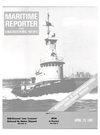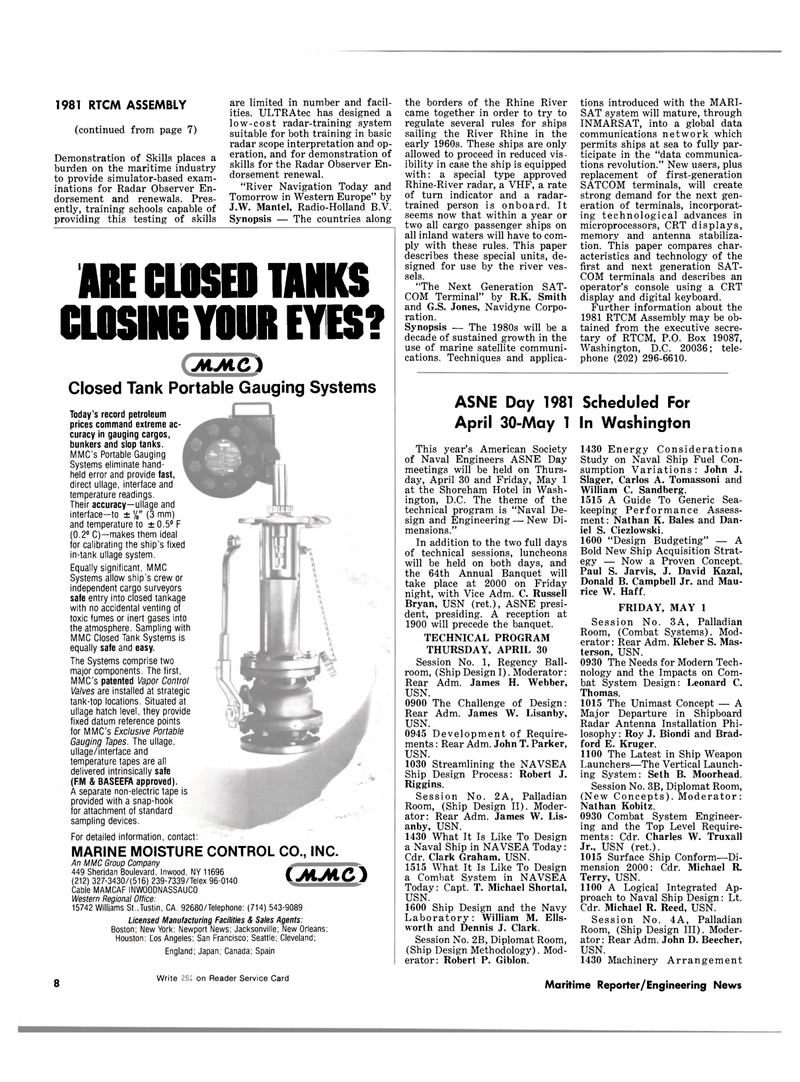
Page 6: of Maritime Reporter Magazine (April 15, 1981)
Read this page in Pdf, Flash or Html5 edition of April 15, 1981 Maritime Reporter Magazine
1981 RTCM ASSEMBLY (continued from page 7)
Demonstration of Skills places a burden on the maritime industry to provide simulator-based exam- inations for Radar Observer En- dorsement and renewals. Pres- ently, training schools capable of providing this testing of skills are limited in number and facil- ities. ULTRAtec has designed a low-cost radar-training system suitable for both training in basic radar scope interpretation and op- eration, and for demonstration of skills for the Radar Observer En- dorsement renewal. "River Navigation Today and
Tomorrow in Western Europe" by
J.W. Mantel, Radio-Holland B.V.
Synopsis — The countries along
ARE CLOSED TANKS
GLQSHK YOUR EYES?
MMC)
Closed Tank Portable Gauging Systems
MARINE MOISTURE CONTROL CO., INC.
An MMC Group Company 449 Sheridan Boulevard, Inwood. NY 11696 (212) 327-3430/(516) 239-7339/Telex 96-0140
Cable MAMCAF INW00DNASSAUC0
Western Regional Office: 15742 Williams St. Justin, CA. 92680/Telephone: (714) 543-9089 (.MMC)
Licensed Manufacturing Facilities & Sales Agents:
Boston; New York: Newport News; Jacksonville; New Orleans;
Houston; Los Angeles; San Francisco; Seattle; Cleveland;
England; Japan; Canada; Spain the borders of the Rhine River came together in order to try to regulate several rules for ships sailing the River Rhine in the early 1960s. These ships are only allowed to proceed in reduced vis- ibility in case the ship is equipped with: a special type approved
Rhine-River radar, a VHF, a rate of turn indicator and a radar- trained person is onboard. It seems now that within a year or two all cargo passenger ships on all inland waters will have to com- ply with these rules. This paper describes these special units, de- signed for use by the river ves- sels. "The Next Generation SAT-
COM Terminal" by R.K. Smith and G.S. Jones, Navidyne Corpo- ration.
Synopsis — The 1980s will be a decade of sustained growth in the use of marine satellite communi- cations. Techniques and applica- tions introduced with the MARI-
SAT system will mature, through
INMARSAT, into a global data communications network which permits ships at sea to fully par- ticipate in the "data communica- tions revolution." New users, plus replacement of first-generation
SATCOM terminals, will create strong demand for the next gen- eration of terminals, incorporat- ing technological advances in microprocessors, CRT displays, memory and antenna stabiliza- tion. This paper compares char- acteristics and technology of the first and next generation SAT-
COM terminals and describes an operator's console using a CRT display and digital keyboard.
Further information about the 1981 RTCM Assembly may be ob- tained from the executive secre- tary of RTCM, P.O. Box 19087,
Washington, D.C. 20036; tele- phone (202) 296-6610.
ASNE Day 1981 Scheduled For
April 30-May 1 In Washington
This year's American Society of Naval Engineers ASNE Day meetings will be held on Thurs- day, April 30 and Friday, May 1 at the Shoreham Hotel in Wash- ington, D.C. The theme of the technical program is "Naval De- sign and Engineering —- New Di- mensions."
In addition to the two full days of technical sessions, luncheons will be held on both days, and the 64th Annual Banquet will take place at 2000 on Friday night, with Vice Adm. C. Russell
Bryan, USN (ret.), ASNE presi- dent, presiding. A reception at 1900 will precede the banquet.
TECHNICAL PROGRAM
THURSDAY, APRIL 30
Session No. 1, Regency Ball- room, (Ship Design I). Moderator:
Rear Adm. James H. Webber,
USN. 0900 The Challenge of Design:
Rear Adm. James W. Lisanby,
USN. 0945 Development of Require- ments : Rear Adm. John T. Parker,
USN. 1030 Streamlining the NAVSEA
Ship Design Process: Robert J.
Riggins.
Session No. 2A, Palladian
Room, (Ship Design II). Moder- ator: Rear Adm. James W. Lis- anby, USN. 1430 What It Is Like To Design a Naval Ship in NAVSEA Today:
Cdr. Clark Graham, USN. 1515 What It Is Like To Design a Combat System in NAVSEA
Today: Capt. T. Michael Shortal,
USN. 1600 Ship Design and the Navy
Laboratory: William M. Ells- worth and Dennis J. Clark.
Session No. 2B, Diplomat Room, (Ship Design Methodology). Mod- erator: Robert P. Giblon. 1430 Energy Considerations
Study on Naval Ship Fuel Con- sumption Variations: John J.
Slager, Carlos A. Tomassoni and
William C. Sandberg. 1515 A Guide To Generic Sea- keeping Performance Assess- ment: Nathan K. Bales and Dan- iel S. Ciezlowski. 1600 "Design Budgeting" — A
Bold New Ship Acquisition Strat- egy — Now a Proven Concept.
Paul S. Jarvis, J. David Kazal,
Donald B. Campbell Jr. and Mau- rice W. Haff.
FRIDAY, MAY 1
Session No. 3A, Palladian
Room, (Combat Systems). Mod- erator : Rear Adm. Kleber S. Mas- terson, USN. 0930 The Needs for Modern Tech- nology and the Impacts on Com- bat System Design: Leonard C.
Thomas. 1015 The Unimast Concept — A
Major Departure in Shipboard
Radar Antenna Installation Phi- losophy : Roy J. Biondi and Brad- ford E. Kruger. 1100 The Latest in Ship Weapon
Launchers—The Vertical Launch- ing System: Seth B. Moorhead.
Session No. 3B, Diplomat Room, (New Concepts). Moderator:
Nathan Kobitz. 0930 Combat System Engineer- ing and the Top Level Require- ments: Cdr. Charles W. Truxall
Jr., USN (ret.). 1015 Surface Ship Conform—-Di- mension 2000: Cdr. Michael R.
Terry, USN. 1100 A Logical Integrated Ap- proach to Naval Ship Design: Lt.
Cdr. Michael R. Reed, USN.
Session No. 4A, Palladian
Room, (Ship Design III). Moder- ator: Rear Adm. John D. Beecher,
USN. 1430 Machinery Arrangement
Today's record petroleum prices command extreme ac- curacy in gauging cargos, bunkers and slop tanks.
MMC's Portable Gauging
Systems eliminate hand- held error and provide fast, direct ullage, interface and temperature readings.
Their accuracy—ullage and interface—to ± %" (3 mm) and temperature to ± 0.5° F (0.2° C)—makes them ideal for calibrating the ship's fixed in-tank ullage system.
Equally significant, MMC
Systems allow ship's crew or independent cargo surveyors safe entry into closed tankage with no accidental venting of toxic fumes or inert gases into the atmosphere. Sampling with
MMC Closed Tank Systems is equally safe and easy.
The Systems comprise two major components. The first,
MMC's patented Vapor Control
Valves are installed at strategic tank-top locations. Situated at ullage hatch level, they provide fixed datum reference points for MMC's Exclusive Portable
Gauging Tapes. The ullage, ullage/interface and temperature tapes are all delivered intrinsically safe (FM & BASEEFA approved).
A separate non-electric tape is provided with a snap-hook for attachment of standard sampling devices.
For detailed information, contact: 8 Write 489 on Reader Service Card Maritime Reporter/Engineering News

 5
5

 7
7
